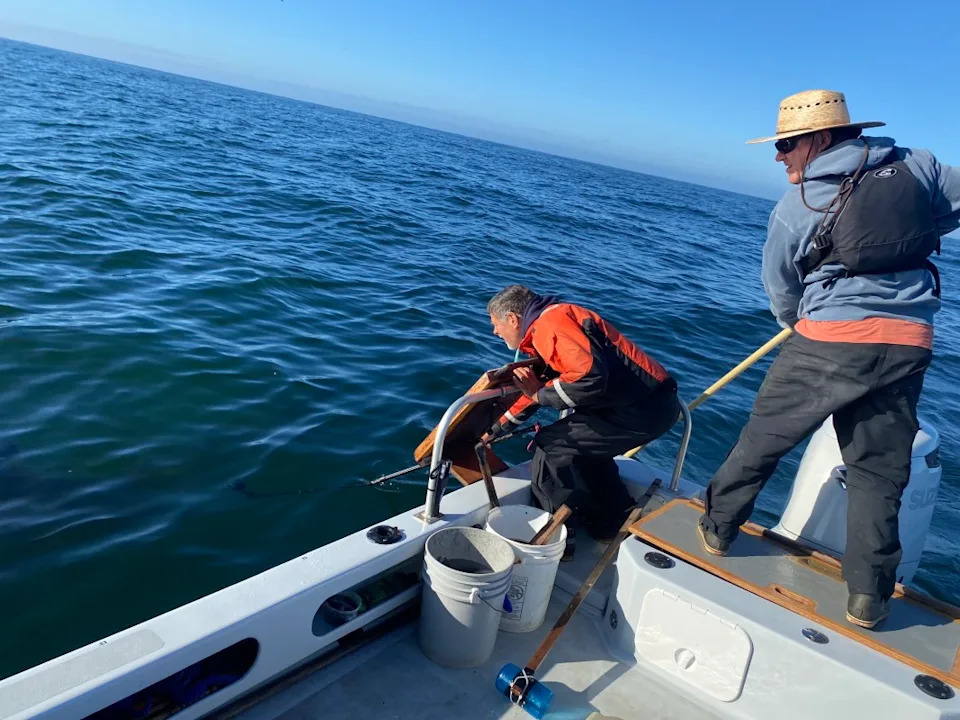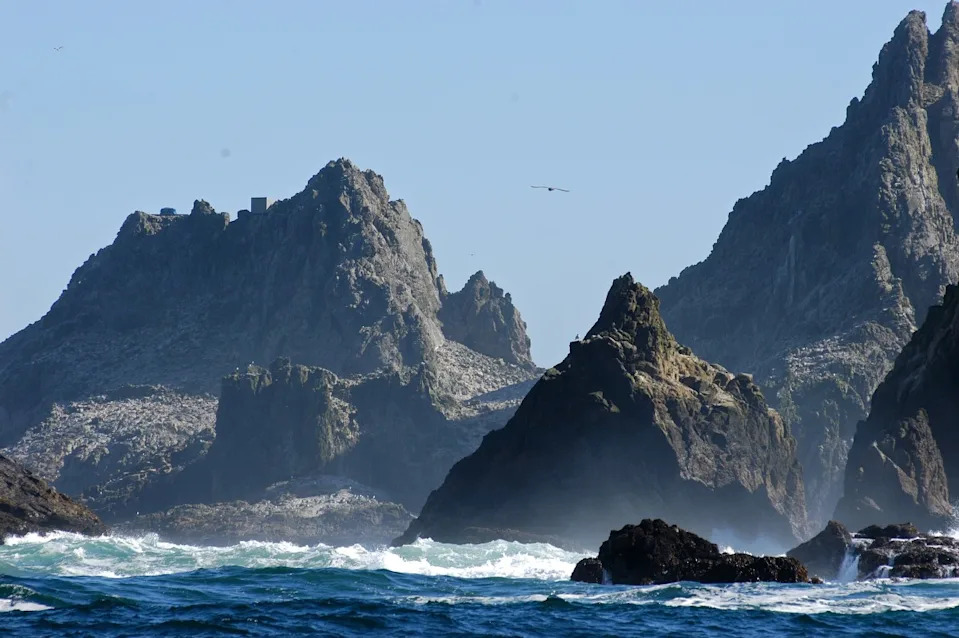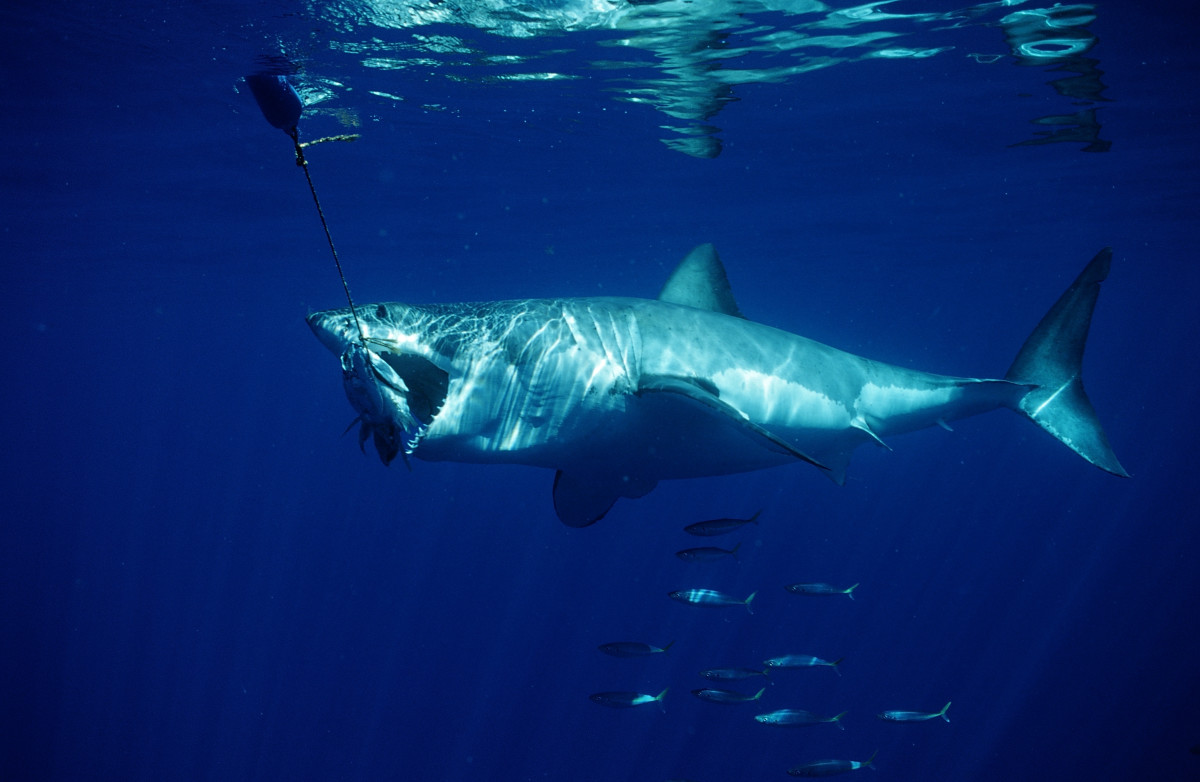Editor’s note: To learn more and support the researchers behind the California White Shark Project, visit the website here.
It’s an hour past dawn on an island off the California coast, and the conditions are sublime. Golden and still, with a touch of northwest groundswell. A classic fall day. Except nobody is in the water, and nobody in their right mind would be. Not here, on the Southeast Farallon Island, where the world’s oldest predators are bulking up.
Within 10 minutes of our arrival last week on Friday morning, a female great white shark silently cruised beneath the Pelicano, a 24-foot Radon vessel. On board stood two men who have spent countless hours here, waiting, watching, studying. Nobody in the state has spent more time looking for hungry adult white sharks at their primary dinner spots than Scot Anderson and Paul Kanive. They’ve been at it for decades: Scot started doing it from the Farallon Islands in 1987, and they’ve worked together for 18 seasons. Their research on white sharks in their natural habitat is the most comprehensive and extensive in the world. They’ve even seen some individuals 26 years apart and given names to usual suspects like Mr. Burns, Brokentail and Yvon Chouinard.
Watching these car-sized creatures glide under the boat, I couldn’t help but be hit with mixed feelings. On one hand, sharks are exceptional creatures, evolution’s proven specimen. When viewed from the safety of a boat, they’re captivating. They are a 400-million-year-old species that outlived dinosaurs.
On the other hand, white sharks are capable of causing horrific damage to humans. Fatal attacks on surfers, while rare, are rattling. As of mid-October, there have been 9 confirmed deaths by sharks in 2025. Tamayo Perry was killed (likely by a tiger shark) while surfing in Hawaii last summer. This year, 57-year-old surf icon Mercury Psillakis was struck down on a reef break near Sydney. Four surfers have been killed in South Australia alone over the previous two years. It’s gotten so bad down in the latter state that researchers in Adelaide are developing bite-resistant wetsuits.
Related: Why Are Sharks Attacking Like Crazy in South Australia?
Despite the dangers, sharks play a crucial role in the marine ecosystem. Not only do they keep other populations in check, but because they need a functional, balanced food chain to survive, they’re a good barometer of ocean health. While we know more about white sharks than ever, there are still information gaps about their mating and births.
When weather and schedules allow each fall, Scot and Paul head 27 miles west of Half Moon Bay and post up for most of the day off the coast of the rocky peaks of the Farallones. Their goal: get as much visual documentation of sharks as possible.
 (left to right) A trio you’re likely to see at the Farallon Islands each fall: a submerged great white shark, Scot Anderson and Paul Kanive.
(left to right) A trio you’re likely to see at the Farallon Islands each fall: a submerged great white shark, Scot Anderson and Paul Kanive.
August Howell
As the first female shark meandered under the boat, the two men hastily got to work. They’ll hate the comparison, but I thought it vaguely resembled dancing. They moved from side to side on the boat, wielding GoPros mounted on long poles. Sex, size, dorsal fins, and other distinguishing features were carefully noted. An interesting fact about identifying sharks is that the dorsal fin is as unique as a fingerprint, so the more evidence acquired, the better the ID. “She’s a big one,” Scot said as casually as if pointing out a family dog.
Related: How To Survive a Shark Attack and Stay Safe From Sharks
Together, Scot and Paul have documented hundreds of white sharks at the Farallones and Tomales Point in Marin County. Some days, they get lots of action, with sharks eating seals not far from the boat. Other days, they will hardly see anything. They’ve even documented one pooping. The researchers’ data suggest there are around 300 adult and sub-adult sharks in this Central California zone, but only about a third were identified as female.
This population was born in Southern California and migrates into California’s Red Triangle (between Bodega Bay, Big Sur and the Farallones) each fall to feed on bountiful pinniped colonies. Most of the white sharks here are large, fully grown males and females, at least 8 feet long and weighing between 2,000 and 3,500 pounds (but considerably more after a meal of blubber).
But after their budget was cut by the Monterey Bay Aquarium in 2020, the result of the facility’s income loss from the coronavirus pandemic, Scot and Paul have continued their work independently. They created the California White Shark Project, a nonprofit organization that funds their ongoing research and education efforts. The goal is to acquire accurate data that better informs conservation policy.
 The Farallon Islands, as dramatic a place as any to study nature’s apex predator.
The Farallon Islands, as dramatic a place as any to study nature’s apex predator.
(Photo by: Kike Calvo/Universal Images Group via Getty Images
One of their more recent studies painted a vivid picture of white shark scars. By identifying certain marks, they can infer what the wounds were caused by and what it means for that individual and the greater population. For instance, by studying bite marks on both sexes, they found that females bite males harder and leave deeper scarring compared to the other way around. The hypothesis is that females fend off unworthy males during mating season. The males that are reproducing with females have to bite for leverage, leaving (relatively) gentle marks, and female great whites have evolved to have thicker skin to compensate.
The mysterious White Shark Cafe, located deep in the Pacific between Hawaii and Baja, is believed to be the white shark’s mating area, a kind of social mingling. But the Farallones are a diner. No small talk, just eating. Sea lions and seals are the shark’s go-to. To tag sharks on the surface, Scot and Paul deploy a seal-shaped yoga mat attached to a fishing rod. The floating decoy is covered in bite marks and had to be stitched together after its previous trip. Scot also dumps saltwater that’s been mixed with blubber (on this trip, it was orca meat), creating an oily slick to add further incentive for the predators (don’t try this at home; these guys have permits for this).
Midway through the day on their latest trip, the crew followed a flock of seagulls to a shredded seal carcass that was so rotten not even the birds wanted it. “Look at how many bite marks are on it,” Scot remarked. After a slow day at the island, the crew decided to call after counting just a handful of sharks. This continuous research isn’t always glamorous, but it is necessary to get an accurate picture of white shark populations. There’s no guarantee of action each time Paul and Scot go to sea. But just like the sharks, they keep coming back.
Related: What’s New With Shark Deterrents, Repellants and Mitigation Technology?
This story was originally reported by Surfer on Oct 20, 2025, where it first appeared in the News section. Add Surfer as a Preferred Source by clicking here.

